Saving the Planet, One Internship at a Time
NREL’s Many Internship Programs Offer Largest Cohort in Laboratory History Opportunity To Make an Impact
“If we want to save the world, this is where we are going to do it.”
Intern Rachel Wnuk’s words summed up how she and many other interns at the National Renewable Energy Laboratory (NREL) feel about their work at the laboratory. It also was the directive U.S. Secretary of Energy Jennifer Granholm had for those interns on a visit to NREL in May 2023.
“I predict you will come away from this experience determined to change the world,” Granholm told the group of interns on their first day at NREL. “This is such an amazing place. You’re going to love it.”
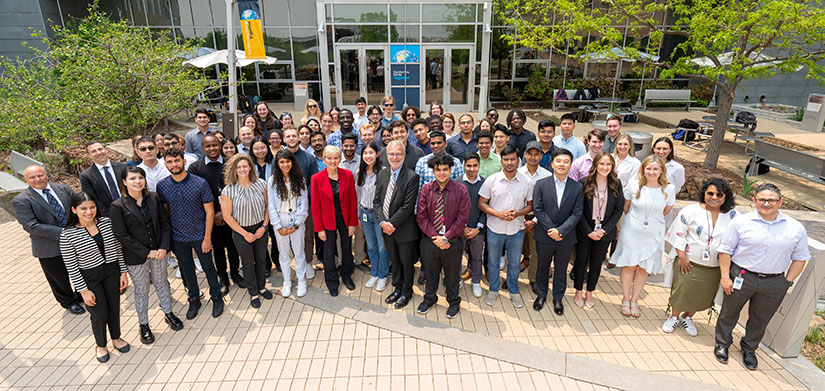
Throughout the summer, more than 400 interns will work at NREL, in person and virtually, making it the laboratory’s largest cohort.
“We have more interns than any year before and most interns on-site since the pandemic,” said Danelle Wilder, postdoctoral and graduate student program manager. “And they are so excited about renewable energy and NREL’s mission.”
Marcus Giron, intern program manager, echoed the feeling of excitement from this group of interns. He also shared that it is not every day the secretary of the Department of Energy (DOE) visits, recognizing the impact that can have on interns.
“To have the secretary visit, it shows how much what we’re doing matters and that people want to be a part of it,” Giron said.
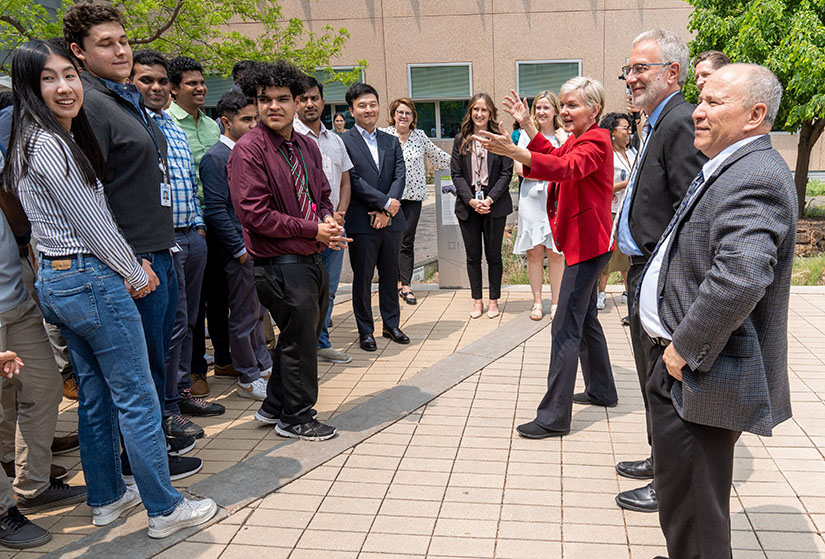
Interns at NREL have been assisting researchers in innovating energy efficiency and renewable energy technologies for over the four decades. The NREL internship programs offer a variety of opportunities to talented, diverse undergraduate and graduate students interested in science, technology, engineering, and mathematics (STEM).
Improving Communities Through People-First Science
Dani Grosboll would not call her education path traditional. After graduating high school, Grosboll was not sure where to go next, and rather than go to college to find a path, she pivoted, traveling to work on coral reef conservation and restoration in Thailand. After returning to the United States, Grosboll enrolled at Arapahoe Community College. That is where she learned about NREL’s Community College Internship program.
“I didn’t know if it was going to be a good fit, but I was like, ‘You know what? Just apply, and worst-case scenario they say no, and you move on. Best case, they say yes, and you get to go!’” Grosboll said.
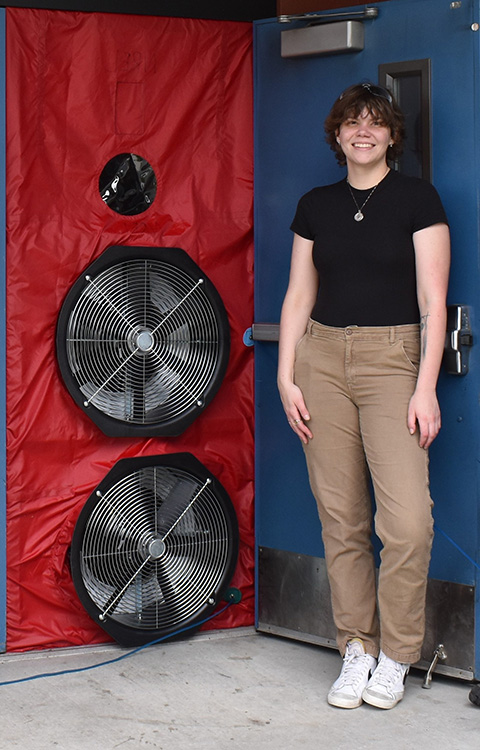
And NREL said yes. The internship program brought Grosboll to Alaska. NREL’s northernmost laboratory, in Fairbanks, Alaska, combines advanced building techniques with community knowledge and guidance to design, research, and build energy efficient, healthy, culturally appropriate homes in the subarctic region.
“I love science, but I also love people,” Grosboll said. “I think renewable energy is awesome, but it’s only awesome if we bring everyone with us as we work on it. I really wanted to work on making sure communities are included in this process and we’re working with everyone.”
Grosboll’s work with NREL focuses on eliminating health hazards and making homes more energy efficient, specifically in the village of Buckland, Alaska. Buckland sits just 40 miles below the Arctic Circle, where conditions are extreme and energy needs are too. The only way to get anything to Buckland is to fly it in, so making things more energy efficient can reduce costs and, in some cases, improve the community’s health.
Much of this work starts with improving ventilation and installing more energy efficient boilers.
“Alaska is very humid, which means lot of opportunities for mold growth. That can be really detrimental to your health, especially for children and elders and those with asthma,” Grosboll said. “We try anything we can to make it safer and a little cheaper for everyone.”
Grosboll’s internship is through the Community College Internship program, which seeks to encourage community college students to enter technical careers relevant to the DOE mission by providing technical training experiences at DOE laboratories. Selected students participate as interns appointed at one of 16 participating DOE laboratories. They work on technologies or instrumentation projects or major research facilities supporting DOE’s mission, under the guidance of laboratory staff scientists or engineers.
Bioinspired, Marine-Energy Powered
It is not often that an intern teaches researchers, but Morgan Jones’ previous intern work with the U.S. Navy proved very interesting and inspiring to NREL researchers. Jones gave a presentation on his previous bioinspired (meaning drawing inspiration from nature, in this case fish) work on marine devices with flapping foils rather than propellors.
“I was really surprised after the presentation—a lot of people were really interested in the work,” Jones said. “This work actually fits really well with some of NREL’s mission space, like the ‘Powering the Blue Economy’ Initiative.”
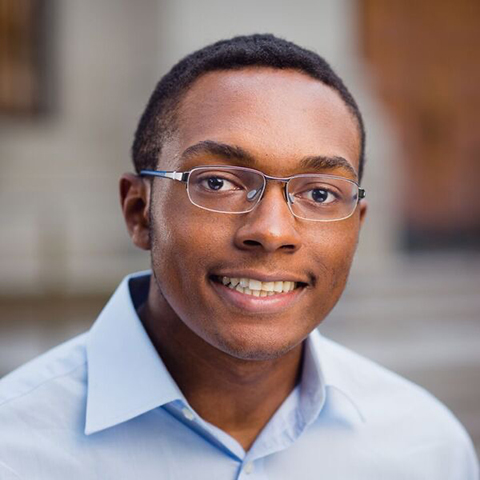
Morgan Jones is a GEM fellow working on marine energy research at NREL. Photo from Morgan Jones
The research, which is fueled by Jones’ work in fluid dynamics, could have implications for underwater robots that use a lot of battery power. Most of those devices use propellors, but flapping fins could prove more energy efficient, extending the time between battery charges or changes. From the energy harvesting aspect, these flapping fins also have the potential to extract power from tides.
“This internship experience made me aware that the research environment here is really cool and the mentors are awesome.”
Jones, currently a PhD student at the University of Southern California and a returning NREL intern, is part of the Graduate Education Minority (GEM) Fellowship program. The National GEM Consortium recruits underrepresented minorities in science, technology, engineering, and math who are in graduate school. The GEM Fellowship provides an opportunity to highly qualified students in need of financial support to pursue an advanced education.
In his initial internship, Jones participated in a resource assessment of the Cook Inlet in Alaska. A highly energetic corner of the Pacific Ocean, Cook Inlet holds one of the greatest tidal resources on Earth. This year, Jones is working with software from the wind energy group to optimize a small-scale marine turbine blade. The motivation is to deploy commercial-scale marine energy, so utilizing these software tools creates a high-performance marine turbine blade is crucial.
Jones credits an undergraduate class at Trinity University for inspiring his love engineering. His first year in the class, his team built shoes that could float on water for walking. The second year, they modified an existing chainsaw for a person with a physical disability.
“These projects really felt like I was working on something that could be used in real-world applications,” he said.
Now Jones’ designs are finding their way into the real world and into the ocean for a marine-powered future. He believes renewable energy has plenty of opportunities for him to dive into with enthusiasm.
“There’s no wrong way of showing your passion and enthusiasm in science and engineering,” Jones said, “and I think maintaining that mindset throughout life that goes a long way.”
From Hurricanes to Hydrogen
Despite making landfall six years ago, Hurricane Maria’s impact still lingers large in Puerto Rico today. For Ambar Maldonado Santos, that impact led her to an internship at NREL.
“Hurricane Maria was disastrous for Puerto Rico. Our electrical grid still hasn’t recovered – we still deal with blackouts and no water because there’s no energy for the water pumps,” Maldonado Santos said. “Ever since then, I knew I wanted to do something related to energy.”
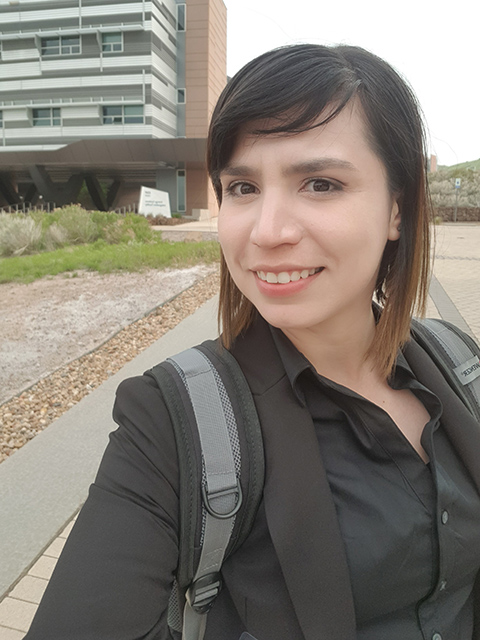
Ambar Maldonado Santos is an NREL intern working on electrolysis for large-scale hydrogen production. Photo by Ambar Maldonado Santos
Maldonado Santos, a graduate student at the University of Puerto Rico, is a part of the RENEW internship program with DOE’s Office of Science. RENEW, which stands for Reaching a New Energy Science Workforce, works with institutions historically underrepresented in the Office of Science’s portfolio. RENEW leverages national laboratories, user facilities, and other research infrastructures to provide training opportunities for undergraduate and graduate students, postdoctoral researchers, and faculty at academic institutions not currently well represented in the U.S. science and technology ecosystem.
Through the internship, Maldonado Santos is working on developing more accessible, cost-effective hydrogen production with her mentors at NREL. She is investigating alkaline electrolysis, a production method that would use metals like iron, nickel, and copper that are more readily available and affordable than more expensive metals currently used by large-scale hydrogen production, while also minimizing greenhouse gas emissions.
“It’s very important to me because global warming is something that’s happening and we need to identify more clean energy sources,” Maldonado Santos said. “I think hydrogen is the future.”
It is not just about developing a renewable energy resource to aid in things like keeping the lights on for Puerto Rico, Maldonado Santos said. Hydrogen could also reduce pollution caused by the car emissions on the tropical island.
“If you want to be able to go the beach and breathe air without gas masks, we need to do something,” she said.
Multilaboratory Energy Planning Support for Puerto Rico
NREL provides Puerto Rico stakeholders with tools, training, and modeling support to enable planning and operation of the electric power grid with more resilience against further disruptions. Since Hurricane Irma and Hurricane Maria in September 2017, NREL has partnered on this effort with DOE and other national laboratories. Learn more about this program.
Strengthening the Grid Through Collaboration
Cybersecurity may seem like a solo endeavor, sitting behind a computer and looking from monitor to monitor. But NREL intern BoHyun Ahn knows it is a team effort.
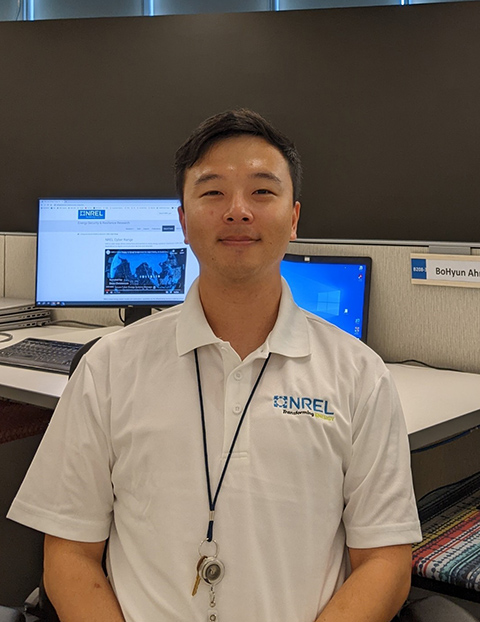
In his NREL internship, BoHyun Ahn is working on cybersecurity research to protect the grid. Photo from BoHyun Ahn
“In school, I was limited because I was one of the few students doing cybersecurity research, so whenever I would face an issue, it was hard to make a breakthrough quickly,” Ahn said. “But at NREL, there are lots of great research, resources, and people. I can easily talk with people. I’m happy to work here with them.”
The Research Participant Program internship that Ahn is a part of focuses on full-time undergraduate and graduate students who are interested in gaining valuable mentoring experience, participating in the laboratory's research and development programs, and establishing ongoing collaborations.
“I’m currently doing very exciting research mentored by Shane McFly,” Ahn said. “I’m learning so many things from this NREL team.”
To go from a solitary effort to working with NREL researchers at the leading edge of cybersecurity for clean energy technologies and highly distributed energy systems has been exciting for Ahn. It has strengthened his desire to go from the theoretical to the real world.
“There’s a gap between the cybersecurity research in academia and real-world cyberattacks,” he said. “I want to reduce that gap. Practical cybersecurity, that is my philosophy of cybersecurity research.”
NREL’s research in the cybersecurity space aims to address critical energy security challenges—like the exponential increase in grid-connected devices, for robust cyber defense, and control of the technology supply chains that directly impact grid services.
Automating for Improved Research
Elijah Smith has taken his love of computer science from a high school robotics team all the way to NREL. As a high school student, Smith found that programing a robot that could do simple tasks, like picking up a disc or throwing a ball, was a fun experience.
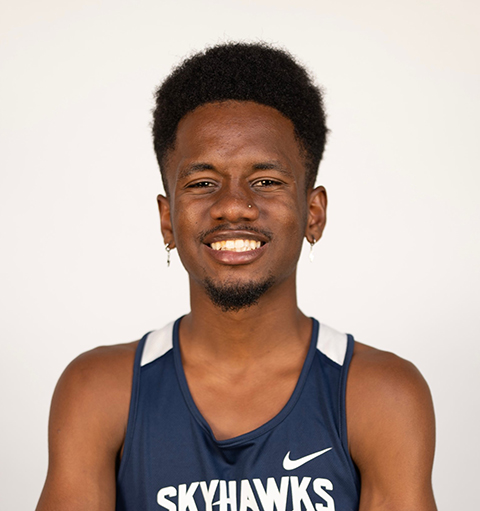
NREL intern Elijah Smith’s work in robotics could have laboratory-wide impacts. Photo from Elijah Smith
At NREL, the robots are doing more than picking up discs. Smith’s internship is automating long processes specifically with electrodialysis, which could have implications across the laboratory.
“A lot of science experiments can take multiple days, even weeks. So rather than having a scientist constantly checking to see if, for instance, the temperature is too high, we’re trying to automate the process,” Smith explained. “It would let the dialysis process autocorrect and be self-sustaining.”
Smith is a STEM Core intern. The program aims to build student engagement and interest in STEM-based careers through programs that emphasize the real-world context in STEM curricula, instruction, and opportunities at leading STEM employers.
Renewable energy is a new space for Smith, but, according to them, that is the beauty of computer science.
“It’s not just computers, it’s the application of the computer,” Smith said. “Using it for renewable energy, I think it’s really fun.”
The main advice Smith has for people interested in STEM fields is to just start. Once you begin, you can start identifying what you like and then extend that to NREL internships.
“Take it all in. If you like certain aspects, ask about them,” they said. “It’s an opportunity to learn about renewable energy, working in government, seeing how things operate. Take advantage of the intern group. Learn and connect.”
Back for More: Internship Part Two
Internships are a brief look into different opportunities. Because they are short, they allow students to get a glimpse of what research at NREL is like, without having to commit to a long appointment. For Rachel Wnuk, that glimpse was not enough.
“I fell in love with the place and the people,” Wnuk said. “It’s been really beneficial, being able to carry on the work I’ve been doing alongside my mentor Maria Kelly.”
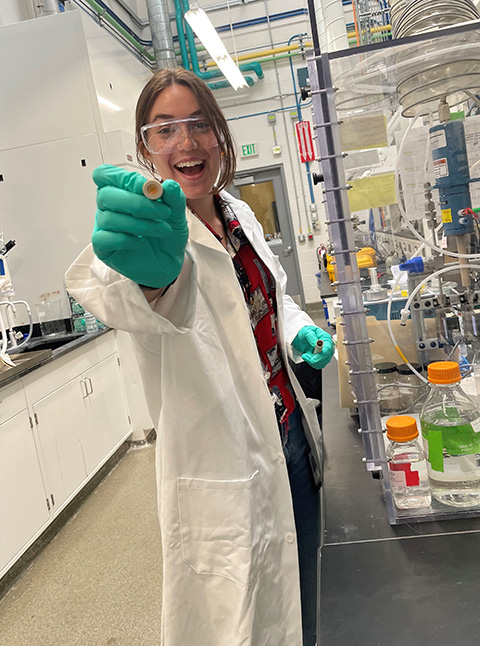
SULI intern Rachel Wnuk, came back to NREL for another internship after enjoying the program and research so much in her first internship. Photo from Rachel Wnuk
Wnuk is on her second internship at NREL. The first one piqued her interest, but the second internship has allowed her to dive deeper into her research. And the research needs a deep dive: Carbon dioxide (CO2) reduction is of vital importance.
“The current problem that we’re trying to solve is the increased output of greenhouse gases that are contributing to climate change and global warming,” Wnuk explained. “So, what we’re doing is converting CO2 into chemicals that provide long-term storage for renewable energies. Current intermittency issues surround the renewable energy sector, but this research works to solve the imbalance between energy supply and demand.”
Wnuk is part of the Science Undergraduate Laboratory Internships (SULI) program, which encourages undergraduate students and recent graduates to pursue science, technology, engineering, and mathematics careers by providing research experiences at DOE laboratories. They perform research, under the guidance of laboratory staff scientists or engineers, on projects supporting the DOE mission.
Despite being nervous and moving somewhere new, Wnuk found everyone welcoming and the setting beautiful. She noted the access to nature and science was a balance she really valued. She also found NREL is full of passionate people working on crucial projects.
“I just fell in love with the place and the people,” she said. “Everybody just seems so passionate about the projects they were working on, and that was infectious to me.”
Learn more about NREL’s internship opportunities.
Last Updated May 28, 2025
